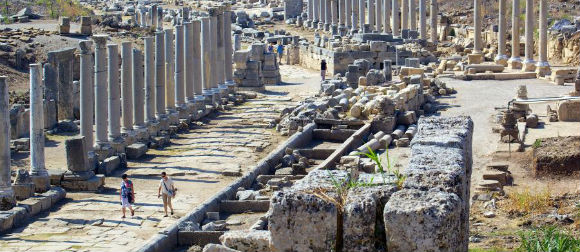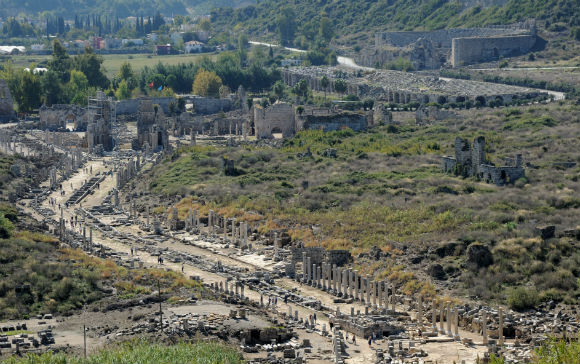The most impressive ruins of the Pamphylian coast are at Perge, at about 15 km east of Antalya. Perge was originally founded by the Hittites around 1500 BC. and was known as Parha. It was a successful trading centre near the Aksu (ancient Kestros or Cestrus) river when Alexander the Great arrived in 333 BC. He was welcomed in by the inhabitants and used Perge as base for his Anatolian campaigns. Alexander was followed by the Seleucids under whom the city prospered and Perge’s most celebrated inhabitant, the mathematician Apollonius from Perge lived and worked. Apollonius was a pupil of Archimedes and wrote a series of eight books on geometry. In 188 BC Perge became part of the Roman Empire during which the city flourished. Most of the surviving buildings date from this period.In 46 AD St. Paul started his journey in Perge (biblical Perga) and preached his first sermon here. Perge gradually declined during the Byzantine period, as the Aksu river silted, but remained inhabited until Selçuk times after which it became abandoned.
A visit to Perge starts by entering the archeological site through the Roman Gate, built during the reign of Septimius Severus (193-211 AD). Proceeding through the gate, to the right is the Agora or market place. This structure of 75 x 75 m dates back from the 2nd century AD. The center courtyard and shops were surrounded by a wide stoa, a covered walkway. The floor of the stoa and shops was made of colored mosaics. The agora was not only the centre of Perge’s trade, but was also a place for meetings as well as a forum for political, social, and philosophical discussions. The next building is the Hellenistic city gate that dates back to the 3rd century BC. This is certainly the most imposing building of the city and was cleverly designed to protect the city with its twin towers and its horseshoe-shaped courtyard at the back. It is thought that the towers had three floors and were crowned by a conical roof. In the year 121 AD, the horseshoe-shaped courtyard was rededesigned as a courtyard of honor. Behind the courtyard stood a triple arch. Around the arch there are about dozen inscriptions connected with Plancia Magna who lived in the 2nd century AD. She was the daughter of the governor, a priestess of Artemis Pergaia (Diana) and a benefactress to the city. Plancia Magna had the arch decorated with the statues of the emperors and their relatives.
After passing through the Hellenistic Gate and courtyard, one enters a broad, marble-paved double-colonnaded street measuring 300 meters in length that extends from the main gate to the acropolis. The street is 20 m wide and is divided in two by a 2 meter wide water channel running down the middle. At the end of the colonnaded street is the Nymphaeum, a triumphal fountain from where a stream flowed down into the water channel. The nymphaeum or nymphaion is an ornamental semicircular structure and dates from the reign of Emperor Hadrian (130-150 AD). A statue of a river god Kestros was located in the center of this huge fountain. Behind the nymphaeum is the acropolis with some remains of the Byzantine period. To the west of the nymphaeum are the remains of a palaestra dating from 50 AD and dedicated to the Emperor Cladius (41-54 AD).
Returning back to the entrance, there are the excavated Roman baths located southwest to the agora. Out of the site proper, is the horsehsoe-shaped stadium, the largest in Asia Minor, measuring 234 m by 34 m. The stadium had a seating capacity of 12,000 people supported by massive barrel-vaulted constructions. Just beyond the site entrance is also the theatre, which is of the Greco-Roman type and could seat 15,000 people. Unfortunately, it is for some time under reconstruction and unfortunately closed to visitors.
Perge,



I visited in March 2011 and was in the area primarily to visit the theater at Aspendos. Outside of the theater there, the ruins don't provide a very good picture of how a city looked in the Roman/Greek era. Perge provides much better ruins on a whole and a good view into the way of life then.
There are certainly…
I enjoyed trying to imagine what it was like when people lived there. Had some interesting thoughts when I saw the public baths.
I went here as part of a tour which only allowed us 1 hour there. Which is great because you have a tour guide to ask questions of, but 1 hour is too short. The Istanbul University archeology students have been spending their summer holiday reconstructing the uncovered ruins and uncovering even more. It's a bummer, because you can see…
Wear hiking boots or shoes with thick soles for this walking trip. Not recommendated for people who are not used to walk on uneven, rugged ground.
This ruin had a different feel than Pompeii in Rome though both are Roman ruins.
Got what we expected, shame the mini coliseum was closed due to repairs. There's a great Agora and loads of nice ruins to get pictures. If you can dont go when its too warm because there's no shadow in there 😉
Most of all I like flowers, carved on marmor. You must be lucky with the gide, lots are under the earth, so we can wait at the site can present us with more in the nearest future
This place just took my breath away! Yes it is ruins and yes it may seem repetitive for those who are not interested in this sort of thing but if history is your thing then it is totally worth a visit! There are some boards (in English too!) which explain the history of the place and what area was for…
This antique town has both museum building and open-air museum. Some of the statues were stolen in near past. Because of climate ,you can easily visit anytime of the year(except heavy rain)My suggestion is :visit this town with a proffesional tourist guide.If you have a time, you can also visit another antique town where Alexander the Great never concoured.
The ruins were much bigger than I expected and they are very nice. We strolled around for 2 hours in the sunset light. A strong recommendation (which goes for many other places):
go there after 4pm, when the masses are leaving. There was almost nobody after 5pm, which gave the whole scenery a unique effect.
On the upper corner I…
Where the locals live, seaside marino lovely view, historic landmarks worth a visit. Do not be intimidated by shop keepers trying to spin you stories to get you to buy anything! They will tell you alsorts, just smile and walk on